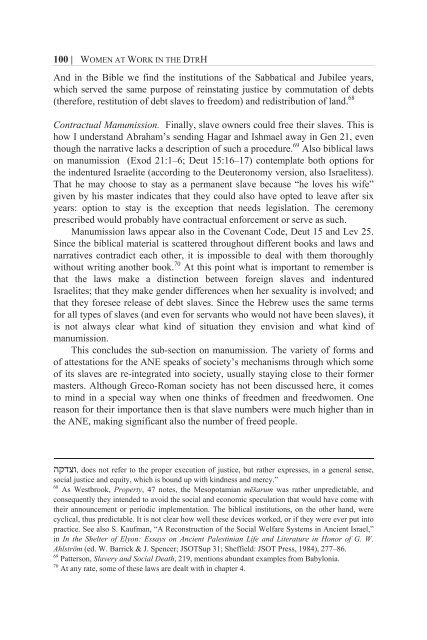Women at Work in the Deuteronomistic History - International Voices ...
Women at Work in the Deuteronomistic History - International Voices ...
Women at Work in the Deuteronomistic History - International Voices ...
Create successful ePaper yourself
Turn your PDF publications into a flip-book with our unique Google optimized e-Paper software.
100 | WOMEN AT WORK IN THE DTRH<br />
And <strong>in</strong> <strong>the</strong> Bible we f<strong>in</strong>d <strong>the</strong> <strong>in</strong>stitutions of <strong>the</strong> Sabb<strong>at</strong>ical and Jubilee years,<br />
which served <strong>the</strong> same purpose of re<strong>in</strong>st<strong>at</strong><strong>in</strong>g justice by commut<strong>at</strong>ion of debts<br />
(<strong>the</strong>refore, restitution of debt slaves to freedom) and redistribution of land. 68<br />
Contractual Manumission. F<strong>in</strong>ally, slave owners could free <strong>the</strong>ir slaves. This is<br />
how I understand Abraham’s send<strong>in</strong>g Hagar and Ishmael away <strong>in</strong> Gen 21, even<br />
though <strong>the</strong> narr<strong>at</strong>ive lacks a description of such a procedure. 69 Also biblical laws<br />
on manumission (Exod 21:1–6; Deut 15:16–17) contempl<strong>at</strong>e both options for<br />
<strong>the</strong> <strong>in</strong>dentured Israelite (accord<strong>in</strong>g to <strong>the</strong> Deuteronomy version, also Israelitess).<br />
Th<strong>at</strong> he may choose to stay as a permanent slave because “he loves his wife”<br />
given by his master <strong>in</strong>dic<strong>at</strong>es th<strong>at</strong> <strong>the</strong>y could also have opted to leave after six<br />
years: option to stay is <strong>the</strong> exception th<strong>at</strong> needs legisl<strong>at</strong>ion. The ceremony<br />
prescribed would probably have contractual enforcement or serve as such.<br />
Manumission laws appear also <strong>in</strong> <strong>the</strong> Covenant Code, Deut 15 and Lev 25.<br />
S<strong>in</strong>ce <strong>the</strong> biblical m<strong>at</strong>erial is sc<strong>at</strong>tered throughout different books and laws and<br />
narr<strong>at</strong>ives contradict each o<strong>the</strong>r, it is impossible to deal with <strong>the</strong>m thoroughly<br />
without writ<strong>in</strong>g ano<strong>the</strong>r book. 70 At this po<strong>in</strong>t wh<strong>at</strong> is important to remember is<br />
th<strong>at</strong> <strong>the</strong> laws make a dist<strong>in</strong>ction between foreign slaves and <strong>in</strong>dentured<br />
Israelites; th<strong>at</strong> <strong>the</strong>y make gender differences when her sexuality is <strong>in</strong>volved; and<br />
th<strong>at</strong> <strong>the</strong>y foresee release of debt slaves. S<strong>in</strong>ce <strong>the</strong> Hebrew uses <strong>the</strong> same terms<br />
for all types of slaves (and even for servants who would not have been slaves), it<br />
is not always clear wh<strong>at</strong> k<strong>in</strong>d of situ<strong>at</strong>ion <strong>the</strong>y envision and wh<strong>at</strong> k<strong>in</strong>d of<br />
manumission.<br />
This concludes <strong>the</strong> sub-section on manumission. The variety of forms and<br />
of <strong>at</strong>test<strong>at</strong>ions for <strong>the</strong> ANE speaks of society’s mechanisms through which some<br />
of its slaves are re-<strong>in</strong>tegr<strong>at</strong>ed <strong>in</strong>to society, usually stay<strong>in</strong>g close to <strong>the</strong>ir former<br />
masters. Although Greco-Roman society has not been discussed here, it comes<br />
to m<strong>in</strong>d <strong>in</strong> a special way when one th<strong>in</strong>ks of freedmen and freedwomen. One<br />
reason for <strong>the</strong>ir importance <strong>the</strong>n is th<strong>at</strong> slave numbers were much higher than <strong>in</strong><br />
<strong>the</strong> ANE, mak<strong>in</strong>g significant also <strong>the</strong> number of freed people.<br />
הקדצו, does not refer to <strong>the</strong> proper execution of justice, but r<strong>at</strong>her expresses, <strong>in</strong> a general sense,<br />
social justice and equity, which is bound up with k<strong>in</strong>dness and mercy.”<br />
68 As Westbrook, Property, 47 notes, <strong>the</strong> Mesopotamian mēšarum was r<strong>at</strong>her unpredictable, and<br />
consequently <strong>the</strong>y <strong>in</strong>tended to avoid <strong>the</strong> social and economic specul<strong>at</strong>ion th<strong>at</strong> would have come with<br />
<strong>the</strong>ir announcement or periodic implement<strong>at</strong>ion. The biblical <strong>in</strong>stitutions, on <strong>the</strong> o<strong>the</strong>r hand, were<br />
cyclical, thus predictable. It is not clear how well <strong>the</strong>se devices worked, or if <strong>the</strong>y were ever put <strong>in</strong>to<br />
practice. See also S. Kaufman, “A Reconstruction of <strong>the</strong> Social Welfare Systems <strong>in</strong> Ancient Israel,”<br />
<strong>in</strong> In <strong>the</strong> Shelter of Elyon: Essays on Ancient Palest<strong>in</strong>ian Life and Liter<strong>at</strong>ure <strong>in</strong> Honor of G. W.<br />
Ahlström (ed. W. Barrick & J. Spencer; JSOTSup 31; Sheffield: JSOT Press, 1984), 277–86.<br />
69 P<strong>at</strong>terson, Slavery and Social De<strong>at</strong>h, 219, mentions abundant examples from Babylonia.<br />
70 At any r<strong>at</strong>e, some of <strong>the</strong>se laws are dealt with <strong>in</strong> chapter 4.




